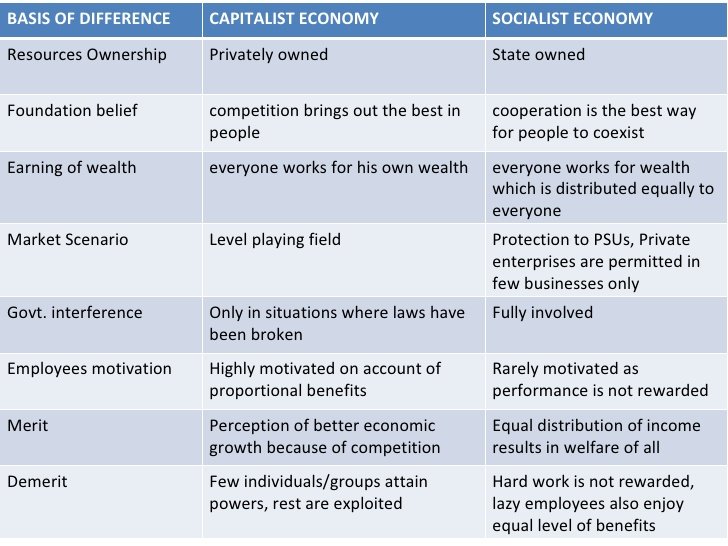TCapitalism and socialism are two different political, economic, and social systems blended together by countries around the world. Sweden is often considered a strong example of a socialist society, while the United States is usually considered a prime example of a capitalist country. In practice, however, Sweden is not strictly socialist, and the United States is not strictly capitalist. Most countries have mixed economies with economic elements of both capitalism and socialism.
Capitalism
Capitalism is an economic system where the means of production are owned by private individuals. “Means of production” refers to resources including money and other forms of capital. Under a capitalist economy, the economy runs through individuals who own and operate private companies. Decisions over the use of resources are made by the individual or individuals who own the company.
In a theoretical capitalist society, companies that incorporate are treated by the same laws as individuals. Corporations can sue and be sued; they can buy and sell property, and perform many of the same actions as individuals.
Under capitalism, companies live by the motivation for profit. They exist to make money. All companies have owners and managers. In small businesses, the owners and managers are generally the same people, but as the business gets larger, the owners may hire managers who may or may not have any ownership stake in the firm. In this case, the managers are called the owner’s agents.
The job of the management is more complex than just making a profit. In a capitalist society, the goal of the corporation is maximizing shareholder wealth.
Under capitalism, it’s the government’s job to enforce laws and regulations to make sure there is a level playing field for privately-run companies. The amount of governing laws and regulations in a particular industry generally depends on the potential for abuse in that industry.
Socialism
Socialism is an economic system where the means of production, such as money and other forms of capital, are owned to some degree by the public (via the state.). Under a socialist system, everyone works for wealth that is in turn distributed to everyone. A socialist economic system operates on the premise that what is good for one is good for all, and vise versa. Everyone works for their own good and for the good of everyone else. The government decides how wealth is distributed among public institutions.
In a theoretical socialist economy, there is a more limited free market than in an archetypal capitalist economy, and thus the taxes are usually higher than in a capitalist system. There are government-run health care and educational systems for tax payers. Socialist systems emphasize more equal distribution of wealth among the people.
Comparison between the Capitalist and Socialist Economies
The main difference between capitalism and socialism is the extent of government intervention in the economy.
A capitalist economic system is characterized by private ownership of assets and business. A capitalist economy relies on free-markets to determine, price, incomes, wealth and distribution of goods.
A socialist economic system is characterized by greater government intervention to re-allocate resources in a more egalitarian way.

There are also different aims of the economic systems.
Equality
- Capitalism is unconcerned about equity. It is argued that inequality is essential to encourage innovation and economic development.
- Socialism is concerned with redistributing resources from the rich to the poor. This is to ensure everyone has both equal opportunities and in some forms of socialism – equal outcomes.
Ownership
- Capitalism: Private businesses will be owned by private individuals/companies
- Socialism: The state will own and control the main means of production. In some models of socialism, ownership would not be by the government but worker co-operatives.
Efficiency
- Capitalism: It is argued that the profit incentive encourages firms to be more efficient, cut costs and innovate new products that people want. If firms fail to keep up, they will go out of business. But, this business failure allows resources to flow to new more efficient areas of the economy. Something known as ‘creative destruction’
- Socialism: It is argued that state ownership often leads to inefficiency because workers and managers lack any real incentive to cut costs. One joke under Soviet Communism was ‘They pretend to pay us. We pretend to work.’
Unemployment
- In capitalist economic systems, the state doesn’t directly provide jobs. Therefore in times of recession, unemployment in capitalist economic systems can rise to very high levels, e.g. 20% + in Great Depression
- Employment is often directed by the state. Therefore, the state can provide full employment even if workers are not doing anything particularly essential. Socialism is sometimes associated with Keynesian demand-management attempts to stimulate the economy in times of slump. Keynes himself was not a socialist.
Price controls
Prices are determined by market forces. Firms with monopoly power may be able to exploit their position and charge much higher prices.
In a state-managed economy, prices are usually set by the government this can lead to shortages and surpluses.
Evaluation
There are many different forms of ‘socialism’ from totalitarian ‘Communist regimes’ To democratic socialist parties in Western Europe, who pursue a pragmatic form of redistribution aiming for equality of opportunity rather than equality of outcome.
Pragmatic socialism
Some forms of socialism, adopt a more pragmatic approach. Many industries are left in private hands a recognition free-markets are more efficient in producing goods. However, the socialist society attempts to use progressive taxation and social spending to provide a minimum safety net. Important public services are run directly by the government.
Responsible capitalism
Many ‘advanced capitalist societies’ have considerable government intervention. The government may provide unemployment benefits and public spending on infrastructure, healthcare and education.
One thought on “Comparison between the Capitalist and Socialist Economies”